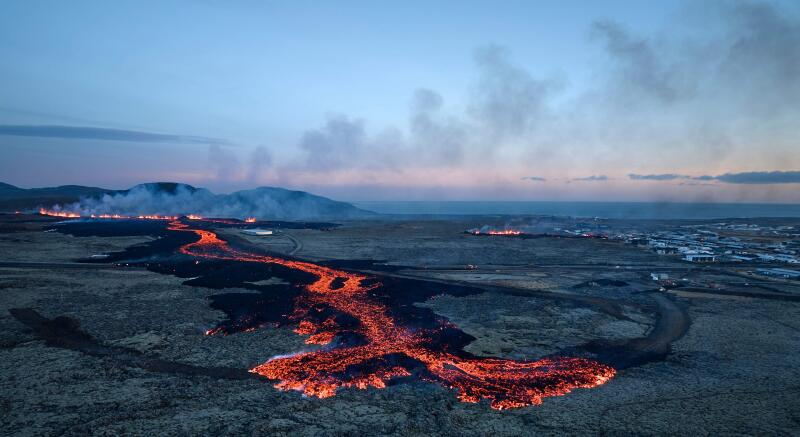What is causing Iceland’s most recent volcanic eruptions?
Since 1240 AD, Iceland’s volcanoes have been dormant, but over the last three years, there has been a significant rise in volcanic activity in Iceland (3). On March 16, 2024, Iceland experienced its fourth volcanic eruption in four months (1). This eruption did not come as a surprise, since earthquakes, an early sign of eruption, had plagued the nation in the two months leading up to the first eruption in December 2023 (2). Towns close to volcanic activity were evacuated, and popular tourist destinations, including the Blue Lagoon Resort & Spa in Grindavík, were temporarily closed to ensure the safety of the public (2). After such a long period without volcanic activity, what is causing the recent increase in volcanic eruptions in Iceland?
Iceland last experienced volcanic activity between 800 AD and 1240 AD, but now, magma is beginning to accumulate beneath Iceland’s surface, leading to increased seismic activity (3). Scientists have attributed Iceland’s recent volcanic activity to two factors: first, Iceland sits on a volcanic “hotspot,” and second, there is movement of the tectonic plates that sit beneath the country (4). Volcanic hotspots occur where there are areas of super-heated rock beneath the Earth’s surface that rise and create eruptions, and tectonic plate movement leads to the development of fissures (4). A fissure is formed when tectonic plates pull apart, causing the Earth’s mantle, the layer between the crust and outer core, to rise and fill the gap (4). Due to the process of convection, the hot material infiltrates low pressure areas (4). As a result, there is volcanic activity on the surface and melting at depth (4).
Iceland’s recent volcanic activity is prevalent throughout the Reykjanes Peninsula, particularly in the town of Grindavík. The Reykjanes Peninsula is home to many fissure-style eruptions, where lava erupts out of newly formed cracks in the ground (6). Furthermore, the mid-Atlantic ridge, a subduction zone caused by the less dense Eurasian plate sinking beneath the heavier North American plate into the mantle, cuts directly through Grindavík, where scientists have found troubling signs that volcanic activity will continue to increase and may be more severe than ever before (4). The Global Positioning System and satellite radar measurements revealed a seven centimeter rise in some parts of the ground in Grindavík, indicating significant movement of the tectonic plates (3). Volcanologists at the Icelandic Meteorological Office observed that molten rock had seeped into a 15-kilometer-long crack in the Earth’s crust, also known as a dike (3). Magma moving beneath the Earth’s crust has caused earthquakes, heightening the possibility of an eruption (3).
What sets the recent eruptions in Grindavík apart from previous eruptions in 2021, 2022, and 2023 is that the dike is much larger and the signs of an impending eruption are progressing much faster than they have in the past (3). In 2021 and 2022, scientists noted the amount of earthquakes and ground deformation dropped in the days before the eruptions occurred, relieving the tectonic stress (3). Moreover, researchers believe that magma began accumulating as early as January 2020, traveling in separate streams towards the surface and flowing much faster than in previous eruptions (3). If an eruption occurs, huge amounts of magma will flow onto the surface due to the increase in effusion rate, the rate at which magma becomes lava (3). Because Iceland’s volcanoes are situated above a hotspot, they will erupt basalt lava, which melts at high temperatures and flows easily (4). Thus, when the lava flows downhill and meets the ocean, it will immediately become steam, and there will be an explosion, scattering ashes over a large area (4).
To identify the signs of an imminent volcanic eruption, volcanologists have repurposed fiber-optic communications cable to detect earthquakes as they occur (3). In addition to these technologies, they have also distributed gas sensors to detect sulfur dioxide and other gasses from the magma, which may have come from as deep as twenty kilometers beneath the surface in the last three eruptions since December (3).
Not only does the possibility of such an explosion threaten the lives of over 3,800 Icelanders living in the neighboring towns but also poses a threat to a nearby geothermal power plant that provides energy for tens of thousands of people (3). Iceland derives 30% of its electricity from geothermal sources that use underground heat to contribute to above ground operations (4). Svartsengi, a hydrothermal plant slightly north of Grindavík, uses underground heat to provide families with hot water by pumping water into wells installed throughout the volcanic field (4). The water boils to steam and is later supplied to turbines and heat exchangers to generate electricity and hot water (4). Even if homes aren’t destroyed, families in the areas neighboring Grindavík will be left without hot water among other things.
Scientists are continuing to observe the notable changes in seismic activity and are predicting future eruptions (6). Benedikt Ófeigsson, a geophysicist at the Icelandic Met Office, says that volcanic eruptions will persist almost every month over the next few months, but in the long-term future, it is uncertain whether the eruptions will last days, weeks, or months (5, 1). Nonetheless, Iceland’s eruptions have surged interest in seismic activity and understanding the origins of Iceland’s unique geographical landscape.
Bibliography:
- Yablonski, S., & Wulfeck, A. (2024, March 16). Iceland volcano continues to spew lava but eruption has stabilized, scientists say. FOX Weather; Fox Weather. https://www.foxweather.com/extreme-weather/volcano-eruption-iceland-alert-lava
- Empty Roads and Spewing Lava: 4 Months Into Iceland’s Eruptions. (2024). The New York Times. https://www.nytimes.com/2024/03/29/world/europe/iceland-volcano-eruption-photos.html
- Iceland braces for volcanic eruption: what scientists are watching. (2023). Nature.com. https://doi.org/10.1038/d41586-023-03631-0
- PBS NewsHour. (2023, November 16). A geologist explains why Iceland may soon see a volcanic eruption. PBS NewsHour. https://www.pbs.org/newshour/science/a-geologist-explains-why-iceland-may-soon-see-a-volcanic-eruption
- Science X. (2024, February 9). Volcanic eruption in Iceland subsides, though scientists warn more activity may follow. Phys.org; Phys.org. https://phys.org/news/2024-02-volcanic-eruption-iceland-subsides-scientists.html#google_vignette
- Robin George Andrews. (2023, December 19). How Dangerous Is Iceland’s New Volcanic Eruption? Scientific American. https://www.scientificamerican.com/article/how-dangerous-is-icelands-new-volcanic-eruption/
Images:

